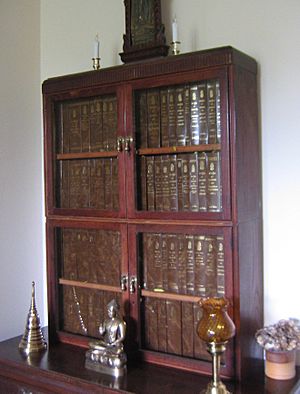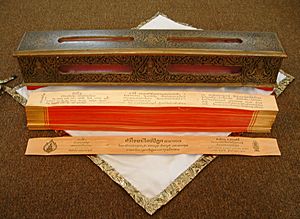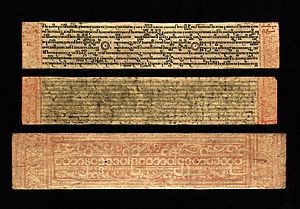Pali Canon facts for kids
|
Basic terms |
|
|
People |
|
|
Schools |
|
|
Practices |
|
|
study Dharma |
|
The Pāli Canon is a very important collection of scriptures (holy writings) for Theravada Buddhists. It's written in the Pāli language and is the most complete collection of early Buddhist teachings we have today. These texts come mainly from a group called the Tamrashatiya school.
After Gautama Buddha passed away, about three months later, a big meeting was held in Rajgir. At this meeting, two of the Buddha's main students, Ananda and Upali, recited all the teachings they remembered. The other wise monks, called Arhats, agreed that these recitations were correct. For a long time, these teachings were passed down by word of mouth, memorized by the Sangha (the community of monks and nuns).
Later, during the time of King Asoka, these teachings, known as the Tipitaka, were brought to Sri Lanka. They were still memorized for many years. Then, around 29 BCE, about 454 years after the Buddha's death, these teachings were finally written down on palm-leaf manuscripts during the Fourth Buddhist Council. Even after being written down, monks continued to memorize and recite the texts for centuries.
| Top - 0-9 A B C D E F G H I J K L M N O P Q R S T U V W X Y Z |
What is the Pali Canon?
The Pāli Canon is divided into three main parts, called pitakas. The word pitaka means "basket" in Pāli, because the palm-leaf writings were kept in baskets. Because there are three parts, the whole collection is called the Tipiṭaka (meaning "three baskets").
The three baskets are:
- Vinaya Piṭaka: This "Discipline Basket" contains all the rules for monks and nuns in the sangha.
- Sutta Piṭaka: This "Sayings Basket" is the largest part. It holds the Buddha's talks, sermons, and some religious poems.
- Abhidhamma Piṭaka: This basket contains detailed explanations of Buddhist ideas, especially about the mind. It's sometimes called the "systematic philosophy" basket.
The Vinaya Pitaka and Sutta Pitaka are very similar to texts from other early Buddhist schools. However, the Abhidhamma Pitaka is mostly unique to the Theravada tradition.
The Canon in Buddhist Practice
Theravada Buddhists believe the Canon contains the "Word of the Buddha" (buddhavacana). This doesn't mean every single word was spoken by the Buddha himself, but that it holds his main teachings and those of his close students.
Even though the Canon has been written down for about 2,000 years, memorizing and reciting parts of it is still very important in Buddhist practice. Many people, even those who are not monks, know short texts by heart and recite them regularly. This is seen as a type of meditation, especially if they understand the meaning. Monks are expected to know much more. For example, a Burmese monk named Vicittasara memorized the entire Canon for the Sixth Council!
How the Canon Began
The Theravada tradition believes that most of the Pali Canon came from the Buddha and his first students. They say that after the Buddha passed away, a council was held to gather and save his teachings. The Canon was passed down orally for about 400 years before being written down in Sri Lanka around 29–17 BCE. The teachings were memorized and regularly recited together by the community.
Many parts of the Pali Canon are also found in the scriptures of other early Buddhist schools in India. These texts were written in different ancient Indian languages, not just Pali. Some were later translated into Chinese. The version we have from Sri Lanka is the most complete, but it was changed and updated around the 5th or 6th century CE.
Scholars have different ideas about who wrote the Pali Canon and when.
- Some scholars believe that the main teachings in the Vinaya and Sutta Pitakas are very consistent and likely came from the Buddha himself. They think his early students helped spread and remember these teachings.
- Other scholars are more careful. They agree that much of the Pali Canon must come from the Buddha's teachings, but also that some parts were added later.
- Some scholars believe that the Pali Canon grew and changed over time from an unknown starting point. They point out that the earliest clear evidence we have about the Canon's contents comes from much later, around the 5th or 6th centuries CE.
The Abhidhamma Pitaka is thought by Western scholars to have started being written around 300 BCE. However, traditional stories say it was also recited at the First Buddhist Council.
Oldest Books in the Canon
Many scholars believe the oldest parts of the Canon are mostly prose works, like the Vinaya (except for one part called Parivāra) and the first four collections of the Sutta Pitaka. Some short verse works, like the Suttanipata, might also be very old.
An edict from King Ashoka (who lived from 304–232 BCE) lists several works from the Canon that he thought were important. This suggests that some of these texts were already set and known during his time.
Pali Canon Texts
Manuscripts
It's hard for old manuscripts to survive in the hot, humid climates of Theravāda countries. Most of the oldest surviving manuscripts we have are from the late 1400s, and not many are from before the 1700s.
Printed and Digital Editions
The first full printed edition of the Canon was published in Burma in 1900. Today, you can find several printed and digital versions:
- The Pali Text Society edition (in Roman letters) was published from 1877–1927.
- The Thai Tipitaka (in Thai script) was published from 1925–1935.
- The Sixth Council Tipiṭaka from Rangoon (1954–1956) is in Burmese script. You can find a digital version of this online for free.
- The Sinhalese (Buddha Jayanti) edition (in Sinhalese script) was published from 1957–1993.
- There are also Cambodian Tipiṭaka (in Khmer script) and a collection of Chinese Pattra Scripture.
Translations
Many parts of the Pali Canon have been translated into English by the Pali Text Society and other groups. However, some of these older translations have been criticized for being difficult to understand for people who are not experts in Buddhism.
More recently, new translations of the main collections of the Sutta Pitaka have been made available for free online by Bhikkhu Sujato.
There are also Japanese and Chinese translations of the Canon.
Contents of the Canon
As mentioned, the Canon has three main parts:
Vinaya Pitaka
The Vinaya Pitaka mainly contains the rules for monks and nuns in the sangha. Each rule usually comes with a story about why the Buddha made that rule. This basket has three parts:
- Suttavibhanga: Explains the Patimokkha, which is a basic set of rules for monks and nuns.
- Khandhaka: Other rules grouped by different topics.
- Parivara: An analysis of all the rules.
Sutta Pitaka
The Sutta Pitaka (meaning "basket of sayings") is mostly about the Buddha's teachings. It has five main collections, called nikayas:
- Digha Nikaya: Contains 34 long talks. Some scholars think this part was meant to help new people become Buddhists.
- Majjhima Nikaya: Has 152 medium-length talks. This part might have been for new converts to get a good understanding of the teachings.
- Samyutta Nikaya: Contains thousands of short talks grouped by subject or person. It has very detailed explanations of Buddhist ideas.
- Anguttara Nikaya: Has thousands of short talks arranged by number (from ones to elevens). It often contains more basic teachings for everyday people.
- Khuddaka Nikaya: A mix of different works, some in prose and some in poetry.
Abhidhamma Pitaka
The Abhidhamma Pitaka (meaning "higher dhamma" or "special dhamma") is a collection of texts that explain Buddhist ideas in a very detailed and systematic way, especially about the mind. It has seven books:
- Dhammasangani: Lists and defines different Buddhist concepts.
- Vibhanga: Analyzes 18 topics using different methods.
- Dhatukatha: Looks at how ideas from the first two books are connected.
- Puggalapannatti: Explains different types of people.
- Kathavatthu: Contains over 200 debates about points of Buddhist teaching.
- Yamaka: Uses a special question-and-answer method for 10 topics.
- Patthana: Analyzes 24 types of conditions.
Many scholars see the Abhidhamma as an effort to organize the teachings found in the Suttas into a more structured system.
Comparison with Other Buddhist Canons
The other two main Buddhist canons used today are the Chinese Buddhist Canon and the Tibetan Kangyur.
The Chinese Buddhist Canon is very large, with over 80,000 pages. It includes rules for different Buddhist schools and four main collections of talks that are similar to the Pali Canon's Nikayas. It also has many other texts, including early histories and detailed philosophical works.
The Tibetan Kangyur has about a hundred volumes. It includes versions of the Vinaya Pitaka and some other books found in the Pali Canon. However, because it was put together later, it has fewer early Buddhist texts compared to the Pali and Chinese canons.
While the Chinese and Tibetan canons are not direct translations of the Pali Canon, they do contain some similar early works. However, their philosophical books (Abhidharma) are very different from the Pali Abhidhamma Pitaka. The Chinese and Tibetan canons also include Mahāyāna sūtras and Vajrayāna tantras, which are not found in the Pali Canon.
See also
 In Spanish: Canon pali para niños
In Spanish: Canon pali para niños
- Access to Insight
- Atthakatha, Pali commentaries on the Pali Canon
- Aṭṭhakavagga and Pārāyanavagga
- Bhikkhu Analayo
- Bhikkhu Bodhi
- Bhikkhu Sujato
- Buddhaghosa
- Buddhist Publication Society
- Dhamma Society Fund
- Dhammapada, one of the most widely read and best known Buddhist scriptures
- Dhammapāla
- Early Buddhist Texts
- Ho trai, library in Thai Temples
- Karl Eugen Neumann
- List of Sāsana Azani recipients
- Ñāṇamoli Bhikkhu
- Niddesa
- Nikāya
- Nyanaponika Thera
- Nyanatiloka Mahathera
- Pali Literature
- Pali Text Society
- Palm-leaf manuscript
- Paracanonical texts (Theravada Buddhism)
- Pariyatti (bookstore)
- Pitakataik
- Rerukane Chandawimala Thero
- Sacca-kiriya
- Sanam Luang Dhamma Studies
- Ṭhānissaro Bhikkhu
- Theravada Buddhism
- Thomas William Rhys Davids
- Tipitakadhara Tipitakakovida Selection Examinations
- Tripiṭaka tablets at Kuthodaw Pagoda





